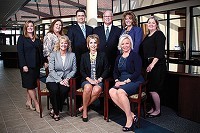YOUR BUSINESS AUTHORITY
Springfield, MO
YOUR BUSINESS AUTHORITY
Springfield, MO

2013 was a momentous year for charitable giving. With growth at nearly five percent, last year represented the largest year-over-year increase in giving since the Great Recession. Wealth advisors have been taking an increasingly active role in providing research to their clients when it comes to finding the right philanthropic organizations they can support.
When a client approaches their wealth advisor seeking more information, they may simply provide the name of a specific non-profit or a short list of key causes they are passionate about. Wherever the starting point begins, a wealth advisor can serve as a resource to outline the key areas of focus to ensure a donor is not only passionate in their support, but also well informed. At the very least, the donor should have a clear assessment of three areas: transparency, communication, and outcomes.
Transparency
When it comes to vetting an organization, gather as much published information as possible. A visit to the website ought to easily point to values, mission, board members and more. A check with the Better Business Bureau (BBB) should also be a first stop. In addition to the BBB, several websites exist in keeping non-profits honest and should be referenced in initial research. At the donor’s request, a wealth advisor may also coordinate a site visit and meeting with the organization’s board or leadership team. This is an excellent way to get to know an organization personally, fostering a broader discussion about the goals and mission at hand for the near and long term future of the charity.
Communication
Many times satisfaction is measured in the communication approach between non-profit and donor. Is the organization invested in building a relationship with the donor? Are they acknowledging gifts in an appropriate manner for the contribution? For example, some donors prefer to have more personalized communication as opposed to an informal letter, or email, while others wish to be left anonymous. In either instance, the wealth advisor can gather a firm understanding of what the donor can expect in terms of communication style and frequency when they begin making their investment.
Outcomes
Perhaps the most common concern with philanthropic giving is whether or not the funds are being used effectively and succeeding in the organization’s mission. Measuring the impact of the gift can be done in many ways. A regular line of communication with donors regarding updates on key projects, goals attained or progress reports, are key indicators of strong leadership at the non-profit.
Wealth advisors have traditionally offered guidance on the tools available to make charitable contributions, tax advantages associated with these gifts and the proper way to fold long term giving into an estate plan. While these functions always remain vital, a wealth management team is also able to assist in pinpointing the ‘why’ behind giving, and assist in the necessary research to match donors with an organization that nourishes that passion and ensures that the partnership continues to be beneficial for all.
Evergreen Hair House opened; the Ozark Chamber of Commerce moved to a new home; and Dirk’s Tavern LLC got its start on C-Street.